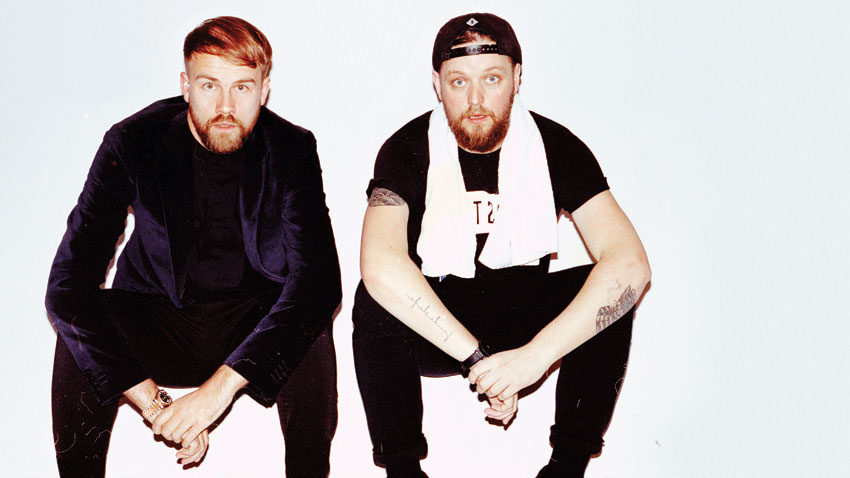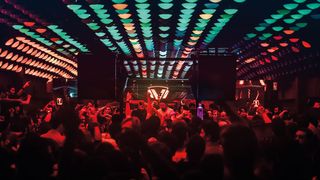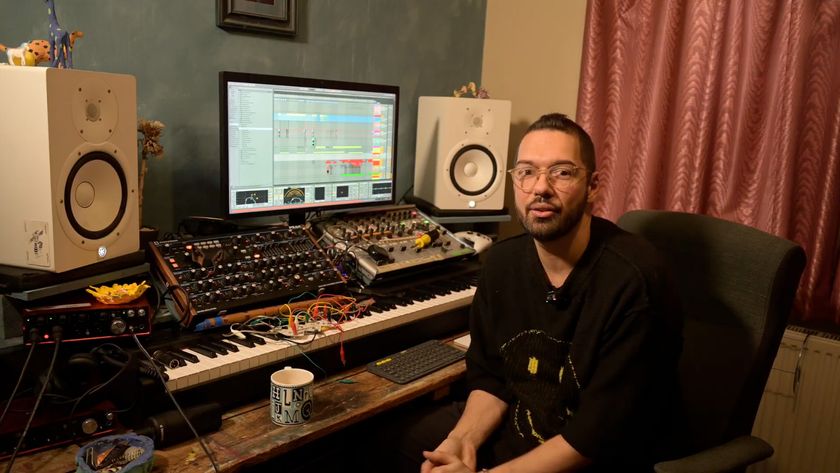Adana Twins on genre boundaries and why they're not in the market for a 303
The Hamburg duo let us in on some of their production techniques

"Listening to the electronic music that's coming out of Germany at the moment is quite weird," says Benni Busse, one half of Hamburg-based production duo the Adana Twins and known to his friends as Take It Easy. "If you look at most European countries, you find that the dance music is pretty much influenced by what happens in the capital city. In Germany, yes, you have the Berlin techno scene, but Hamburg is known as a house city. There was the 90s sound in Frankfurt, interesting tunes coming out of Munich and Cologne, and some great hip-hop from Stuttgart."
"Maybe that's why we find it so difficult to give a name to the music we play," adds Friso Traas. "There are strong melodic elements to some of our songs, but there are also house rhythms, funky basslines and some darker techno themes. What do you call that? I have no idea!"
Catching Hamburg's attention with a regular night on the legendary Reeperbahn - often playing marathon ten-hour sets - the Twins soon hooked up with other local names like Davidé, Doctor Dru, Monte, and Kruse & Nuernberg. Although it took a while for word to spread outside the city, 2012's singles Everyday and Strange soon took their dark 'n' funky philosophy across the globe."
A string of remix offers and tour dates - plus appreciative nods from the likes of Pete Tong and A-Trak - kept them pretty busy, but they've just finished work on a new EP, Perspective, which is out now.
Just picking up that point about the connection between a city and the music that gets made there… it's something journalists have spent a lot of time analysing over the years - maybe too long! Could the Detroit sound have only come from Detroit? Was dubstep really born in Croydon? In 2016, electronic music is no longer confined by borders; it's global. Does it really matter where a 'sound' comes from? Within weeks, it's everywhere and racking up millions of hits on YouTube. Maybe Adana Twins could have been formed in New York, Sydney, Bangkok… Penzance?
Benni Busse: "Personally, I do think that a place can have an influence on the sound. If I hear something that's from Amsterdam or Cologne, I can pretty soon tell that's where it's from. If I hear music from the UK, I can tell that there's a certain sound. Not 100% of the time, but I do think that a place and the people who live there all feed into the music.
"When we're touring, we often get people talking to us about Kraftwerk coming from Düsseldorf or the music that was coming out of Frankfurt in the 90s, and they want to visit these places. I guess they want to try and understand why the music came from this particular place at this particular time. They want to soak up the atmosphere.
Get the MusicRadar Newsletter
Want all the hottest music and gear news, reviews, deals, features and more, direct to your inbox? Sign up here.
"Who knows? Maybe we had to be in Hamburg otherwise the music would sound totally different."
Neither of you is from Hamburg. How did you end up there?
Friso Traas: "We both went to university here. When we first arrived, the scene was a bit more indie and new wave… we were listening to lot of stuff from the Ed Banger label. Since then, Hamburg has moved on, and I think we've moved on. As we got older, we seemed to like things sounding darker and more emotional.
"It's interesting to listen back to some of the music we were making in those early days, just to see how the approach to production has changed. When we first started working together, we knew exactly how we wanted the music to sound. It was a very natural process… almost as if we didn't have to think about it. Making music felt quite simple and easy.
"But the more time you spend making music, the more you explore sound and structures. We both studied classical music a little when we were younger; I guess we wanted to introduce elements that would make the music interesting for us and for people listening to it."
Even in your more minimal tunes, there are always a few good strong hooks. As if you're sort of writing a pop song.
FT: "We don't mind pop; we don't mind a song being catchy, but you have to make sure you don't go too far from the dancefloor. That's the great thing about working as a duo: you can keep watch over each other and the song."
"All these people that were supposed to be gangsters didn't look like gangsters. There was too much pretending"
Where did Adana's funk come from?
BB: "I listened to a lot of hip-hop when I first started DJing… until everyone started trying to act like a gangster. For me, that felt wrong. All these people that were supposed to be gangsters didn't look like gangsters. There was too much pretending.
"We also loved listening to things like Soul Clap and Tanner Rose; Keinemusik from Berlin. Funk is the thing that moves you; it stops the music being too quantised. We often work with this amazing funk piano player, and if you try to quantise what he's playing - even by a very small amount - it will lose everything. If you look at how the notes are on the MIDI page, it looks totally crazy and you try to make sense
of it. Don't! Just enjoy how it sounds and don't try to analyse it. Chords you can quantise, but don't try quantising everything else or you'll lose the soul."
What were you working on back in the early days?
FT: "Luckily, we had a lot of friends and, through the club scene, we knew a lot of producers. Without that community and that help in the early period, we would have had some problems. I think maybe that's still the same for young people who want to get into music today. If there's someone you can call and say, 'Why is this happening? Why is this synth not working?' you'll make your life easier.
"We were first introduced to Logic, but then we settled with Ableton [Live] and that's what we still use today."
BB: "For us, Ableton is just a recording machine. We use the compression, the EQ and the Drum Rack, but most of our sounds come from third-party software. I hope that doesn't sound like I'm complaining about Ableton… it's fantastic. I can't really think of one problem we have with it. OK, maybe the individual elements on the production side could be fine-tuned, but you have to be careful that you're not trying to search for perfection."

You've mentioned u-he's Diva in a lot of interviews.
FT: "It's probably the main synth for both of us. One of those synths that sounds so good the second you get it on screen. The filters have a nice analogue feel, and it's very easy to feel your way around. At times, I wonder if we rely on it too much, but the more I dig into Diva, the more great sounds I find in there.
"Because production deadlines are so tight these days, we seem to spend a lot of our time trying to write songs on planes and in airports; Diva has become very useful in these situations because we know that we can access instantly useful sounds. Those sounds might get changed or even replaced completely as the production process goes on, but Diva will always give you some great ideas to start with.
"We have a saying in Germany: Weniger ist mehr. I think you have the same one in English: Less is more. Sure, we could have 50 different synths in the studio, but you'd never have time to really understand the sound of so many."
BB: "We also use the TAL 101 and the D16 Phoscyon; both of them are 303 emulations. From what I've read, these aren't the most realistic 303 machines out there, but that's not a problem for us because we aren't too interested in the genuine 'acid sound' - I think you hear much more of that coming from the UK at the moment.
"We'd love to try a real 303, but they're way too expensive for us. If we had that much money to spend on equipment, I think I'd rather invest it into other things for the studio.
"It's the same for our drum sounds. We have D16 Drumazon, which is a 909 emulation. We've just got a TR-8, too. Is it as good as the real thing? I don't know because I've never had the opportunity to compare the two, but as we're never likely to be able to afford the real thing, this is a suitable replacement. It works for us and that's all that matters."
FT: "We also use quite a lot of samples, too; all coming via Ableton's Drum Rack. I suppose you could say most of our songs start with a rhythm, but we're not afraid to cut back the drums if they feel too strong on the finished track.
"For us, the drums are a good indication of how good the song is sounding. As the song is coming together, we get the drums in their own group and try to make sure that they feel right… check the spectrum analyser, make sure the kick is really cutting through, find out where the hats are working best.
"Whenever young producers ask us for tips or advice, I always tell them to use the analyser and spend time finding out 'where' sounds work. Look at the wave, tweak the hats and, wow, they'll suddenly cut through at 8k or whatever. A good producer will understand sound."
BB: "That doesn't mean you can't break the rules. Sometimes, you put together a song in a way that you think should work, but it doesn't. That's when you have to just trust your ears. That kick shouldn't work with this song, but it does!"
FT: "I get really excited when I find a sound that really makes a song move. The other day, we were working on a track and there was just a simple kick with this strange rhythmic noise working in the higher frequencies. It was only those two elements, but, suddenly, there was a groove."
Do you prefer to keep things simple, or is the computer maxed out with sounds and stems?
FT: "[Laughs] I guess we'd like to say that we try to keep things simple, but that's not always easy. We use a lot of compression and EQ, so a simple production can suddenly get quite complex. We start digging into waves, and there's a nice tool from Cableguys called VolumeShaper. That's a great compressor for sidechaining and adding some rhythm to a sound.
"We also seem to end up adding lots of little bits of synth and percussion; a bit of Sylenth1, a bit of Arturia V. Sometimes, it's only when you add the vocal and start thinking about mastering that you realise you've probably gone too far. There's no room left in the song. Like we said… sometimes, less is more."
Earlier, you said you generally start a song with drums. Can you talk us through a production?
BB: "That's not so easy because there are so many random elements to every song; nothing is ever the same. Generally, we work together in the studio and tend to break things down to melodies and rhythms… pulling the track in two different directions, but making sure they work together.
"Yes, the beat is a starting point, but then a song can go wherever it wants. We did some recording last year in LA with these incredible speakers. The song sounded fantastic, but when we got the song back to Germany and into our own studio, we realised there was still some fine-tuning, and several times we had to play it out to make sure the sound was OK. A final mix can often be a very long way from your original idea."
"We seem to spend a lot of our time trying to write songs on planes and in airports"
Alongside your software favourites, you've also got some classic hardware in the studio: a Juno-106, a DX7… anything you really feel is missing?
FT: "There's already enough software out there to keep any producer happy for a long, long time. Where DAWs are concerned, I don't think there's much they can really keep adding… and maybe it's the same with the synths. What I think we'll see is small adjustments that will make each piece of software a little bit better.
"For me, the next big leap could be in hardware - an interface that will really allow you control a DAW the same way you'd control a Minimoog. Yes, we already have the touchAble app, Ableton Push and Native Instruments' Maschine, but it still doesn't feel like the perfect interface between you and the DAW.
"When you program a Minimoog it feels very natural, and I think that's what we need next: something that will work in a different way to everything we've had before. It will complete the circle between the human and the computer."
Perspective, the new single from Adana Twins and Human Life is out now.


Computer Music magazine is the world’s best selling publication dedicated solely to making great music with your Mac or PC computer. Each issue it brings its lucky readers the best in cutting-edge tutorials, need-to-know, expert software reviews and even all the tools you actually need to make great music today, courtesy of our legendary CM Plugin Suite.

“My love letter to a vanished era that shaped not just my career but my identity”: Mark Ronson’s new memoir lifts the lid on his DJing career in '90s New York

“I'm always starting up sessions and not finishing them, but I don't see that as unproductive”: Virtuosic UK producer Djrum talks creativity and making Frekm Pt.2









